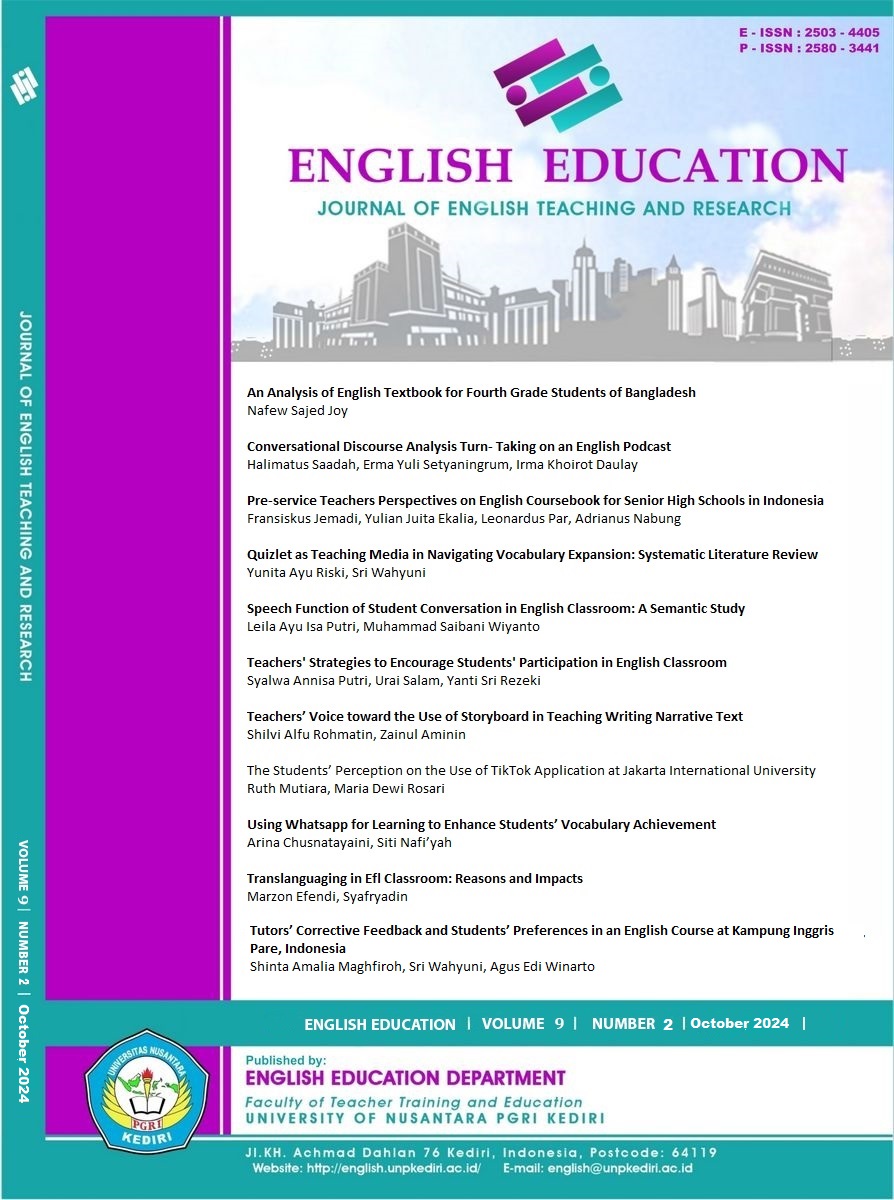Translanguaging in Efl Classroom: Reasons and Impacts
DOI:
https://doi.org/10.29407/jetar.v9i2.23185Keywords:
impacts, reasons, translanguaging, impacts, translanguagingAbstract
Translanguaging is an educational method that involves using two languages or more interchangeably for both receiving and producing information within a single activity. In Kurikulum Merdeka, English becomes one of the compulsory subjects for elementary school students. The lack of vocabularies and other factors support the elementary school English teacher to employ translanguaging in the education setting. This research aims to explore the reasons and impacts of translanguaging usage in the classroom. The kind of this research is descriptive qualitative research. The researcher involved three English teachers from one of Sekolah Penggerak Batch 1. The researcher employed two data collection techniques (open-ended questionnaires and semi-structured interviews). The results are there are eight reasons of translanguaging in EFL classroom, namely the lack of vocabularies mastery, to make the instruction clearer for the students, to engage the students and make them active, to create a comfort and joyful learning environment, to avoid misconception of learning materials, the students’ request, the limitation of time in EFL classroom, and to reduce students’ anxiety. There are five impacts of translanguaging, namely making the students become more active, the learning objective can be reached optimally, the students’ English skills and comprehension get better, the students can understand the instruction well, and the students can enjoy the learning process. The researcher suggests the next researcher to conduct the research about the practice of translanguaging in elementary school.
Downloads
References
Anwar, W., Salija, K., & Abduh, A. (2014). Exploring translanguaging: an approach to teaching and learning English as foreign language of Bone Islamic University Context. http://eprints.unm.ac.id/id/eprint/14952
Baker, C. (2011). Foundations of Bilingual Education and Bilingualism (5th ed.). Clevedon: Multilingual Matters.
Berlianti, D. G. A., & Pradita, I. (2021). Translanguaging in an EFL classroom discourse: to what extent it is helpful for the students? Communication in humanity and social science, 1(1), 42–46. https://doi.org/10.21924/chss.1.1.2021.14
Bin-Tahir, S. Z., Saidah, U., Mufidah, N., & Bugis, R. (2018). The impact of translanguaging approach on teaching. Ijaz Arabi Journal of Arabic Learning, 1(1), 22–29. https://ejournal.uin-malang.ac.id/index.php/ijazarabi/article/view/4932
Canagarajah, S. (2011). Translanguaging in the classroom: emerging issues for research and pedagogy. In Applied Linguistics Review (2). https://doi.org/10.1515/9783110239331.1
Cenoz, J., & Gorter, D. (2017). Minority languages and sustainable translanguaging: threat or opportunity?, Journal of Multilingual and Multicultural Development, 38 (10), 901-912
Erdin, Y., & Salı, P. (2020). Translanguaging : insights into its theoretical underpinnings and classroom implications. Journal of Language Research, 4(1), 1–11. https://dergipark.org.tr/en/pub/jlr/issue/54148/707898
Garcia , O., Johnson, S. I., & Seltzer, K. (2017). The translanguaging classroom: Leveraging student bilingualism for learning. Philadelphia, PA: Caslon.
Hafidzah, A. N., Qashas, A., Noni, N., & Korompot, C. A. (2023). Students’ perceptions on translanguaging in English teaching-learning process. Journal of Excellence in English Language Education, 2(3), 332–341.
Khairunnisa, K., & Lukmana, I. (2020). Teachers’ attitudes towards translanguaging in Indonesian EFL classrooms. Jurnal Penelitian Pendidikan, 20(2), 254–266. https://doi.org/10.17509/jpp.v20i2.27046
Lestari, D., Asrori, M., Indriyani, E., & Handayani, P. (2022). The English pre-service teachers’ perception toward translanguaging in EFL classroom. English Education Journal, 10(2), 109–119. https://jurnal.uns.ac.id/englishedu/article/view/57742
Liando, N. V. F., Tatipang, D. P., & Lengkoan, F. (2022). A study of translanguaging practices in an EFL classroom in Indonesian context: a multilingual concept. Research and Innovation in Language Learning, 5(2), 167. https://doi.org/10.33603/rill.v5i2.6986
Marsevani, M., & S, H. J. (2023). Translanguaging practices in language classrooms. International Journal of Research in Education, 3(2), 239–247. https://doi.org/10.26877/ijre.v3i2.15911
Rabbidge, M. (2019). The effects of translanguaging on participation in EFL classrooms. Journal of Asia TEFL, 16(4), 1305–1322. https://doi.org/10.18823/asiatefl.2019.16.4.15.1305
Raja, F. D., Suparno, S., & Ngadiso, N. (2022). Students’ attitude towards translanguaging practice in Indonesian EFL classes. AL-ISHLAH: Jurnal Pendidikan, 14(1), 979–988. https://doi.org/10.35445/alishlah.v14i1.1149
Rerung, M. K. T. (2018). Reflecting translanguaging in classroom practices: a case study. Journal of English Language and Culture, 7(1). https://doi.org/10.30813/jelc.v7i1.1019
Riswanto, R. (2022). Exploring translanguaging as a pedagogical strategy used by the English teacher in EFL classroom setting. JPGI (Jurnal Penelitian Guru Indonesia), 7(1), 96. https://doi.org/10.29210/021948jpgi0005
Sanjaya, M. M., & Sumardi, J. N. (2023). Students’ FLA and their perspectives on translanguaging practices in Indonesian EFL classrooms. English Language & Literature International Conference, 6(1), 406–420.
Santoso, W., & Hamied, F. A. (2022). Towards multilingual education: pre-service English teachers’ perceptions of translanguaging pedagogy. Prosiding Konferensi Linguistik Tahunan Atma Jaya (KOLITA), 20(20), 364–374. https://doi.org/10.25170/kolita.20.3817
Silalahi, R. M. P., & Santoso, W. (2023). Exploring Indonesian teachers’ and students’ perceptions and practices of translanguaging and trans-semiotizing in EFL classrooms. VELES: Voices of English Language Education Society, 7(1), 86–95. https://doi.org/10.29408/veles.v7i1.10199
Yasar Yuzlu, M., & Dikilitas, K. (2022). Translanguaging in the development of EFL learners’ foreign language skills in Turkish context. Innovation in Language Learning and Teaching, 16(2), 176–190. https://doi.org/10.1080/17501229.2021.1892698
Downloads
Published
Issue
Section
License
Authors who publish with this journal agree to the following terms:
- Copyright on any article is retained by the author(s).
- The author grants the journal, the right of first publication with the work simultaneously licensed under a Creative Commons Attribution License that allows others to share the work with an acknowledgment of the work’s authorship and initial publication in this journal.
- Authors are able to enter into separate, additional contractual arrangements for the non-exclusive distribution of the journal’s published version of the work (e.g., post it to an institutional repository or publish it in a book), with an acknowledgment of its initial publication in this journal.
- Authors are permitted and encouraged to post their work online (e.g., in institutional repositories or on their website) prior to and during the submission process, as it can lead to productive exchanges, as well as earlier and greater citation of published work.
- The article and any associated published material is distributed under the Creative Commons Attribution-ShareAlike 4.0 International License








 Article template
Article template



